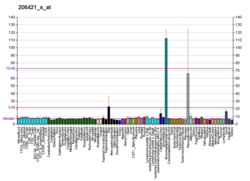Protein-coding gene in the species Homo sapiens
| SERPINB7 |
|---|
|
| Identifiers |
|---|
| Aliases | SERPINB7, MEGSIN, PPKN, TP55, serpin family B member 7 |
|---|
| External IDs | OMIM: 603357; MGI: 2151053; HomoloGene: 68363; GeneCards: SERPINB7; OMA:SERPINB7 - orthologs |
|---|
| Gene location (Human) |
|---|
 | | Chr. | Chromosome 18 (human)[1] |
|---|
| | Band | 18q21.33 | Start | 63,752,935 bp[1] |
|---|
| End | 63,805,376 bp[1] |
|---|
|
| Gene location (Mouse) |
|---|
 | | Chr. | Chromosome 1 (mouse)[2] |
|---|
| | Band | 1|1 E2.1 | Start | 107,327,385 bp[2] |
|---|
| End | 107,380,419 bp[2] |
|---|
|
| RNA expression pattern |
|---|
| Bgee | | Human | Mouse (ortholog) |
|---|
| Top expressed in | - skin of arm
- skin of leg
- human penis
- skin of abdomen
- skin of thigh
- skin of hip
- epithelium of nasopharynx
- vulva
- testicle
- bronchial epithelial cell
|
| | Top expressed in | - skin of external ear
- belly cord
- skin of abdomen
- skin of back
- olfactory epithelium
- lip
- esophagus
- condyle
- fossa
- cervix
|
| | More reference expression data |
|
|---|
| BioGPS |  | | More reference expression data |
|
|---|
|
| Gene ontology |
|---|
| Molecular function | - peptidase inhibitor activity
- serine-type endopeptidase inhibitor activity
| | Cellular component | - cytoplasm
- extracellular space
| | Biological process | - positive regulation of collagen biosynthetic process
- positive regulation of transforming growth factor beta1 production
- negative regulation of peptidase activity
- positive regulation of glomerular mesangial cell proliferation
- positive regulation of platelet-derived growth factor production
- negative regulation of endopeptidase activity
| | Sources:Amigo / QuickGO |
|
| Orthologs |
|---|
| Species | Human | Mouse |
|---|
| Entrez | | |
|---|
| Ensembl | | |
|---|
| UniProt | | |
|---|
| RefSeq (mRNA) | |
|---|
NM_001040147
NM_001261830
NM_001261831
NM_003784 |
| |
|---|
| RefSeq (protein) | |
|---|
NP_001035237
NP_001248759
NP_001248760
NP_003775 |
| |
|---|
| Location (UCSC) | Chr 18: 63.75 – 63.81 Mb | Chr 1: 107.33 – 107.38 Mb |
|---|
| PubMed search | [3] | [4] |
|---|
|
| Wikidata |
| View/Edit Human | View/Edit Mouse |
|
Serpin B7 is a protein that in humans is encoded by the SERPINB7 gene.[5]
See also
References
- ^ a b c GRCh38: Ensembl release 89: ENSG00000166396 – Ensembl, May 2017
- ^ a b c GRCm38: Ensembl release 89: ENSMUSG00000067001 – Ensembl, May 2017
- ^ "Human PubMed Reference:". National Center for Biotechnology Information, U.S. National Library of Medicine.
- ^ "Mouse PubMed Reference:". National Center for Biotechnology Information, U.S. National Library of Medicine.
- ^ "Entrez Gene: SERPINB7 serpin peptidase inhibitor, clade B (ovalbumin), member 7".
Further reading
- Tsujimoto M, Tsuruoka N, Ishida N, et al. (1997). "Purification, cDNA cloning, and characterization of a new serpin with megakaryocyte maturation activity". J. Biol. Chem. 272 (24): 15373–80. doi:10.1074/jbc.272.24.15373. PMID 9182567.
- Miyata T, Nangaku M, Suzuki D, et al. (1998). "A mesangium-predominant gene, megsin, is a new serpin upregulated in IgA nephropathy". J. Clin. Invest. 102 (4): 828–36. doi:10.1172/JCI2450. PMC 508946. PMID 9710452.
- Inagi R, Miyata T, Suzuki D, et al. (2001). "Specific tissue distribution of megsin, a novel serpin, in the glomerulus and its up-regulation in IgA nephropathy". Biochem. Biophys. Res. Commun. 286 (5): 1098–106. doi:10.1006/bbrc.2001.5509. PMID 11527413.
- Inagi R, Miyata T, Imasawa T, et al. (2003). "Mesangial cell-predominant gene, megsin". Nephrol. Dial. Transplant. 17 Suppl 9 (90009): 32–3. doi:10.1093/ndt/17.suppl_9.32. PMID 12386281.
- Inagi R, Miyata T, Nangaku M, et al. (2003). "Transcriptional regulation of a mesangium-predominant gene, megsin" (PDF). J. Am. Soc. Nephrol. 13 (11): 2715–22. doi:10.1097/01.ASN.0000033507.32175.FA. PMID 12397041.
- Strausberg RL, Feingold EA, Grouse LH, et al. (2003). "Generation and initial analysis of more than 15,000 full-length human and mouse cDNA sequences". Proc. Natl. Acad. Sci. U.S.A. 99 (26): 16899–903. Bibcode:2002PNAS...9916899M. doi:10.1073/pnas.242603899. PMC 139241. PMID 12477932.
- Li YJ, Du Y, Li CX, et al. (2004). "Family-based association study showing that immunoglobulin A nephropathy is associated with the polymorphisms 2093C and 2180T in the 3' untranslated region of the Megsin gene". J. Am. Soc. Nephrol. 15 (7): 1739–43. doi:10.1097/01.ASN.0000130858.00688.46. PMID 15213261.
- Suzuki Y, Yamashita R, Shirota M, et al. (2004). "Sequence comparison of human and mouse genes reveals a homologous block structure in the promoter regions". Genome Res. 14 (9): 1711–8. doi:10.1101/gr.2435604. PMC 515316. PMID 15342556.
- Gerhard DS, Wagner L, Feingold EA, et al. (2004). "The status, quality, and expansion of the NIH full-length cDNA project: the Mammalian Gene Collection (MGC)". Genome Res. 14 (10B): 2121–7. doi:10.1101/gr.2596504. PMC 528928. PMID 15489334.
- Inagi R, Nangaku M, Usuda N, et al. (2005). "Novel serpinopathy in rat kidney and pancreas induced by overexpression of megsin". J. Am. Soc. Nephrol. 16 (5): 1339–49. doi:10.1681/ASN.2004070600. PMID 15788472.
- Xia Y, Li Y, Du Y, et al. (2006). "Association of MEGSIN 2093C-2180T haplotype at the 3' untranslated region with disease severity and progression of IgA nephropathy". Nephrol. Dial. Transplant. 21 (6): 1570–4. doi:10.1093/ndt/gfk096. PMID 16431886.
- Xia YF, Huang S, Li X, et al. (2006). "A family-based association study of megsin A23167G polymorphism with susceptibility and progression of IgA nephropathy in a Chinese population". Clin. Nephrol. 65 (3): 153–9. doi:10.5414/cnp65153. PMID 16550745.
External links
- The MEROPS online database for peptidases and their inhibitors: I04.012
- SERPINB7+protein,+human at the U.S. National Library of Medicine Medical Subject Headings (MeSH)
This article incorporates text from the United States National Library of Medicine, which is in the public domain.

















